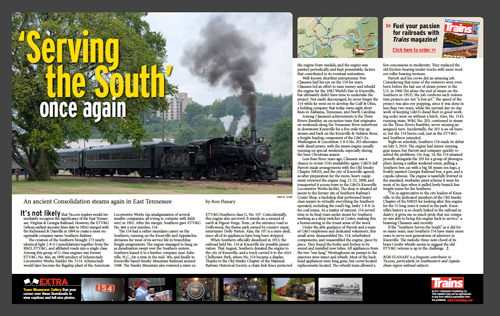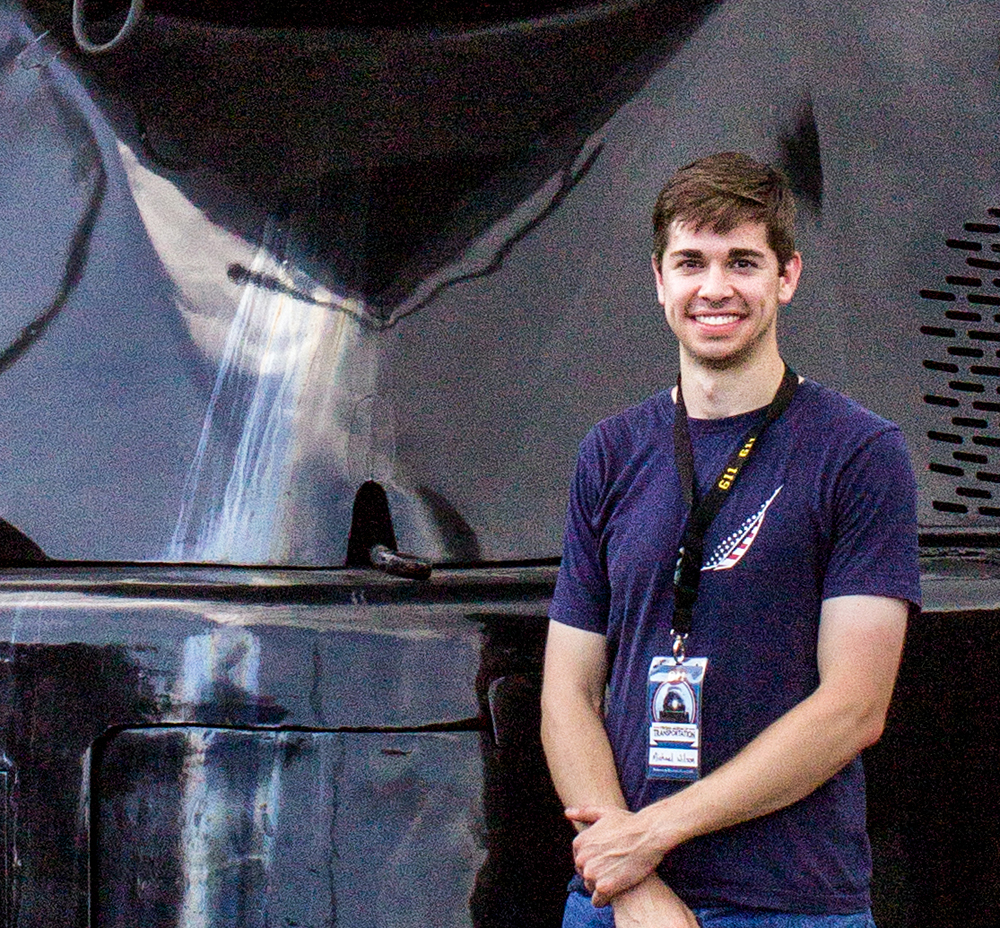The creation of the Southern brought 173 nearly identical light 2-8-0 Consolidations together from the R&D, ETV&G, and affiliated roads into a single class. Among this group of G-class engines was former ETV&G No. 466, an 1890 product of Schenectady Locomotive Works, builder No. 3114. Schenectady would later become the flagship plant of the American Locomotive Works (an amalgamation of several smaller companies, all trying to compete with Baldwin) in 1901. After the merger, Southern gave ETV&G No. 466 a new number, 154.
The 154 had a rather mundane career on the Southern, running on the Knoxville and Appalachia divisions for most of its service life in branchline freight assignments. The engine managed to hang on as dieselization swept over the Southern system. Southern leased it to a lumber company near Asheville, N.C., for a time in the mid-’40s, and finally to Knoxville-based Smoky Mountain Railroad around 1948. The Smoky Mountain also rostered a sister ex-ETV&G/Southern class G, No. 107. Coincidentally, this engine also survived. It stands on a mound of earth at Pigeon Forge, Tenn., at the entrance road to Dollywood, the theme park owned by country music entertainer Dolly Parton. Alas, the 107 is a mere shell, since all of its appliances have long been stripped.
When Southern officially dieselized in 1953, the railroad held No. 154 at Knoxville for possible preservation. That August, Southern donated the engine to the city of Knoxville, and a truck carried it to the city’s Chilhowee Park, where No. 154 became a display. Thanks to the Old Smoky Chapter of the National Railway Historical Society, a chain link fence protected the engine from vandals, and the engine was painted periodically and kept presentable, factors that contributed to its eventual restoration.
Well-known shortline entrepreneur Pete Claussen had his eye on the 154 for years. Claussen led an effort to raise money and rebuild the engine for the 1982 World’s Fair in Knoxville, but ultimately didn’t have time to undertake the project. Not easily discouraged, he never forgot the 154 while he went on to develop the Gulf & Ohio, a holding company that today owns eight short lines in Alabama, Tennessee, and North Carolina.
Among Claussen’s achievements is the Three Rivers Rambler, an excursion train that originates on weekends along the Tennessee River waterfront in downtown Knoxville for a five-mile trip upstream and back on the Knoxville & Holston River, a freight-hauling component of the G&O. Ex-Washington & Lincolnton 2-8-0 No. 203 alternates with diesel power, with the steam engine usually running on special weekends, especially during the busy Christmas season.
Less than three years ago, Claussen saw a chance to revisit 154’s availability again. G&O’s Jeff Parrott made arrangements with the Old Smoky Chapter NRHS, and the city of Knoxville agreed; so after preparation for the move, heavy equipment retrieved the engine Aug. 21-22, 2008, and transported it across town to the G&O’s Knoxville Locomotive Works facility. The shop is situated adjacent to the former site of Southern Railway’s Coster Shop, a backshop that performed heavy class repairs to virtually everything the Southern operated, including the road’s big, lanky 2-8-8-2s for coal trains. As a matter of interest, 154 served time in its final years under steam for Southern working as a shop switcher at Coster, making this a homecoming in the truest sense of the word.
Under the able guidance of Parrott and a team of G&O employees and dedicated volunteers, this small army disassembled No. 154, refurbished components, and reassembled the engine, piece by piece. They found the boiler and firebox to be sound and installed new tubes. All appliances from the two “one lung” Westinghouse air pumps to the injectors were intact and rebuilt. Most of the backhead appliances were long gone, but crews located replacements located. The rebuild team allowed a few concessions to modernity. They replaced the old friction-bearing tender trucks with more modern roller bearing versions.
Parrott and his crews did an amazing job. Considering that none of the restorers were even born before the last use of steam power in the U.S. in 1960 (let alone the end of steam on the Southern in 1953), the job confirms such restoration projects are not “a lost art.” The speed of the project was also eye-popping, since it was done in less than two years, while the normal day-to-day work of keeping G&O’s diesel fleet in good working order went on without a hitch. Also, No. 154’s running mate, W&L No. 203, continued to steam on the Three Rivers Rambler, never missing an assigned turn. Incidentally, the 203 is an oil burner, but the 154 burns coal, just as the ETV&G and Southern intended.
Right on schedule, Southern 154 made its debut on July 3, 2010. The engine had minor running gear issues, but Parrott and company quickly resolved the problems. On Aug. 14, the 154 steamed proudly alongside the 203 for a group of photographers during a railfan weekend event, pulling a Southern box car with a big SR steam-era logo, a freshly painted Georgia Railroad box, a gon, and a cupola caboose. The engine is tastefully liveried in the standard, workaday paint scheme it wore for most of its days when it pulled lowly branch line freight trains for the Southern.
“I’m so appreciative to the city leaders of Knoxville, to the dedicated members of the Old Smoky Chapter of the NRHS for looking after this engine for the 55 long years it rested in the park. Knoxville’s history is so clearly linked to the railroad industry; it gives me so much pride that our company was able to bring this engine back to service,” a beaming Claussen said recently.
If the “Southern Serves the South” as it did for so many years, may Southern 154 have many more years to serve new generations of admirers in Knoxville. The melodic three-note chord of its brass Crosby whistle seems to suggest the old ETV&G veteran is up to the challenge. 2
RON FLANARY is a frequent contributor to Trains, particularly on Southeastern and Appalachian region railroad subjects.














